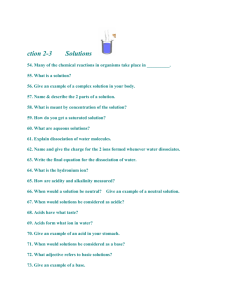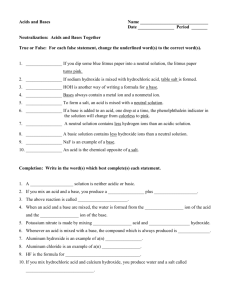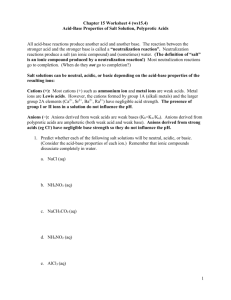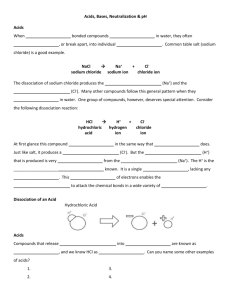Acids and Bases Ch. 19
advertisement
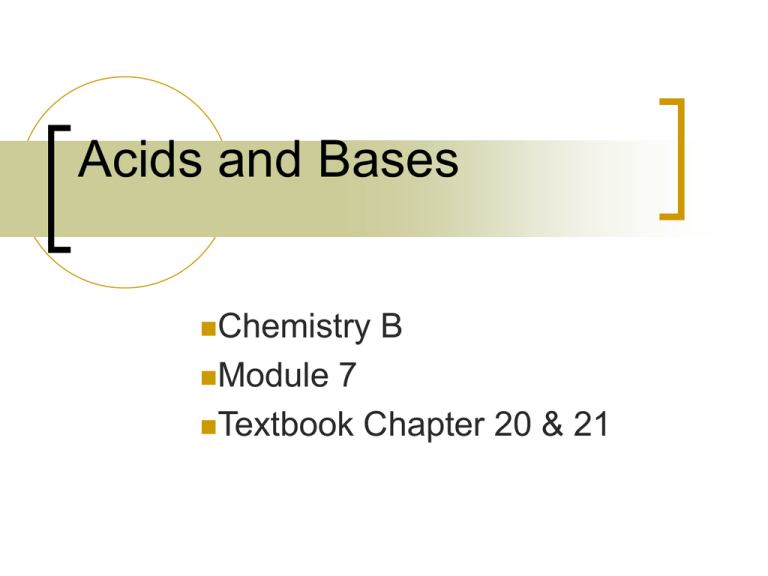
Acids and Bases Chemistry Module B 7 Textbook Chapter 20 & 21 Acids Give up H+ when dissolved in water Turn litmus red Clear in Phenolphthalein Sour taste Has pH < 7 Reacts with metal to form hydrogen (H2) gas Naming Acids (Review) Page 2 of flip book Acids start with Hydrogen Binary acids are Hydro___ic Acid Ternary acids take their name from the polyatomic ion Sulfate ion is Sulfuric Acid (H2SO4) Nitrite ion is Nitrous Acid (HNO2) Bases Gives up (OH)- when dissolved in water Turns litmus blue Pink in Phenolphthalein Bitter taste Feels slippery Has pH > 7 Naming Bases (Review) Page 2 of flip book Write the name of the metal and roman numeral (if needed) Add the hydroxide NaOH is Sodium hydroxide Fe(OH)2 is Iron (II) Hydroxide Acid-Base Theories Arrhenius Acidsubstance that produces a hydrogen ion in solution Bronsted Lowry Acid- hydrogen ion donor Lewis Acids Accepts a pair of electrons. Page 3 of flip book Arrhenius Base – a substance when in a water solution gives up an (OH)-1 Bronsted Lowry Base – hydrogen ion acceptor Lewis Bases- An electron pair donor Strong vs. Weak Bases Page 4 of flip book A base is strong if it contains a group I or II metal; ionizes completely Ex. NaOH A base is weak if it contains any other metal or (NH4)+; ionizes slightly Strong or Weak Acids? There are only 6 strong acids: You must learn them. The remainder of the acids therefore are considered weak acids. Page 4 of flip book HCl H2SO4 HNO3 HClO4 HBr HI Note: when a strong acid dissociates only one H+ ion is removed. H2S04 dissociates giving H+ and HS04- ions. H2SO4 → H+ + HSO41A 0.01 M solution of sulfuric acid would contain 0.01 M H+ and 0.01 M HSO41- (bisulfate or hydrogen sulfate ion). Page 5 of flip book Common Acids and their Uses Hydrochloric acid (HCl) in gastric juice Sulphuric acid (H2SO4) Nitric acid (HNO3) Carbonic acid in softdrink (H2CO3) Uric acid in urine Ascorbic acid (Vitamin C) in fruit Citric acid in oranges and lemons Acetic acid in vinegar Tannic acid (in tea and wine) Tartaric acid (in grapes) Common Bases/Uses Page 5 of flip book Sodium hydroxide (NaOH) or caustic soda used to make soap and biodiesel, plus much more! Calcium hydroxide ( Ca(OH)2 ) or limewater Ammonium hydroxide (NH4OH) or ammonia water - a household cleaner Magnesium hydroxide ( Mg(OH)2 ) or milk of magnesia – used as an antacid or a laxative Many bleaches, soaps, toothpastes and cleaning agents Page 6 of flip book Conjugate Acids and Bases Based on the work by Bronsted-Lowery Examples: HCl + NaOH => acid base proton proton donor acceptor HCl acid + NH3 base NaCl + H 2O conjugate conjugate base acid => NH4+ + conjugate acid Clconjugate base Sample Problems Label the reaction with the following: Acid, base, conjugate acid, conjugate base F-1 + H2O HF + OH-1 NH3 + H-1 NH2-1 + H2 pH Scale relationship between [H+] and pH pH = -log [H+] Definition of acidic, basic, and neutral solutions based on pH acidic: if pH is less than 7 basic: if pH is greater than 7 neutral: if pH is equal to 7 Explore Page 7 of flip book Indicators Page 7 of flip book Acid - Base indicators (also known as pH indicators) are substances which change color with pH. They are usually weak acids or bases, which when dissolved in water dissociate slightly and form ions. http://www.elmhurst.edu/~chm/vchembook/180acidsbases.html Other pH indicators Cabbage Juice Red-acid Blue-base Strawberry Juice Universal Indicator http://www.seed.slb.com/en/scictr/lab/food_ph/res.htm pH 2 - pink pH 4 - Orange pH 6 - Yellow pH 8 - Aqua/Blue pH 10 - Blue pH 12 - Violet http://encarta.msn.com/media_1461500642/Universal_Indicator.html pH Calculation Page 8 of flip book Convert to Molarity and put into the pH equation scientific calculators are a MUST for most of these. 1) 0.0015 2) 5.0 x 10¯9 3) 1.0 x 10-3 4) 3.27 x 10¯4 5) 1.00 x 10¯12 6) 0.00010 pH = -log[H+] pH + pOH = 14 pOH is based on the concentration of hydroxide ion. pOH = -log[OH-1] pH + pOH = 14 Page 9 of flip book Neutralization Neutralization one type of double replacement reaction Acid + Base Salt + water Net ionic equation shows what drives the neutralization reaction HCl(aq) + NaOH(aq) NaCl(aq) + H2O(l) Page 10 of flip book Neutralization Problems HBr + Ca(OH)2 -------> How many moles of Ca(OH)2 will it take to neutralize 15 moles of HBr? Steps 1. Write a balanced neutralization reaction 2. Identify want and given 3. Convert given to moles M x L = Moles 4. Convert moles of given to moles of want by using coefficients. (ratio) 5. Calculate the molarity of want = Moles/L = M Sample Problem When 45.0 mL of 3.00 M HBr is added to 80.0 mL of Ca(OH)2 What is the molarity of the Ca(OH)2 that was neutralized? Titration Concepts Titration- The process which involves finding the concentration of an unknown solution by using a certain volume of a known solution. End point- The point where neutralization is achieved and the indicator has changed color. Page 11 of flip book Titration Equation MacidVacid = MbaseVbase Hydrolysis of Salts definition of a salt: Page 12 of flip book an ionic compound made of a cation and an anion, other than hydroxide. the product besides water of a neutralization reaction When you place a salt in water you get an acid and a base. Then you have to determine if your new solution is acidic or basic Determining acidity or basicity of a salt solution split the salt into cation and anion add OH- to the cation a. if you obtain a strong base. the cation is neutral b. if you get a weak base, the cation is acidic Add H+ to the anion a. if you obtain a strong acid, the anion is neutral b. if you obtain a weak acid. the anion is basic Determining acidity or basicity of a salt solution, cont. Salt solutions are neutral if both ions are neutral Salt solutions are acidic if one ion is neutral and the other is acidic Salt solutions are basic is one of the ions is basic and the other is neutral. The acidity or basicity of a salt made of one acidic ion and one basic ion cannot be determined without further information. Acidic, Basic or Neutral? Strong Acid Strong Base Neutral Salt Strong Acid Weak Base Acidic Salt Weak Acid Strong Base Basic Salt Weak Acid Weak Base Neutral Salt Sample Problems 1. Cu(NO3)2 2. KC2H3O2 Sample Answer An aqueous solution of KC2H3O2 will be basic. The K+ is the cation of a strong base (KOH), thus it is a neutral ion and has no effect on the pH of the solution. The C2H3O2- is from a weak acid (HC2H3O2), thus it is a basic ion. This compound in an aqueous solution will, therefore, form a basic solution. Sample Problem Answer An aqueous solution of Cu(NO3)2 will be acidic. The Cu2+ is the cation of a weak base (Cu(OH)2), thus it is an acidic ion and has an effect on the pH of the solution. The NO3- is from a strong acid (HNO3), thus it is a neutral ion. This compound in an aqueous solution will, therefore, form an acidic solution.
